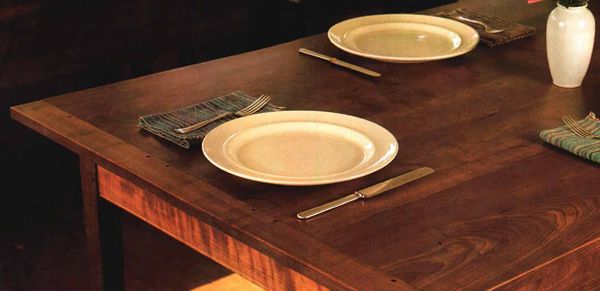Breadboard Ends Hold Panels Flat
Four ways to make this fundamental joint
Synopsis: Garrett Hack says breadboard ends are an elegantly practical way to keep desktops, tabletops, chest lids, and other panels flat. Here, he explains quick, simple breadboarding and various ways to attach them – splines, tongue and grooves, and dovetails. And he talks about how the best breadboards have separate tenons with a stub tongue. He explains how to make all these joints in detail, and photos illustrate the steps clearly.
Sooner or later every woodworker has to come to terms with breadboard ends. You can reject them as nonessential elements, or you can reject them just because they take time and effort to make and attach. But if you want an elegantly practical way to keep desktops, tabletops, chest lids and other panels flat, adding breadboard ends is the way to go.
But what are breadboard ends (sometimes, they are called just breadboards) anyway? Basically, a breadboard is just a narrow board (or batten) at the end of and running cross-grain to a panel, preventing the panel from cupping. To attach the breadboard to the panel, you need a joint that keeps the end snug to the end grain of the top. The joint must be strong enough not to break off (even if the panel is picked up by the breadboard end itself), yet it still must allow the top to expand and contract with seasonal changes in humidity.
Fortunately, there are a number of useful joints for attaching breadboard ends, ranging from crude but functional to fine and elegant, though more time-consuming, solutions. All share a tongue and groove or sliding dovetail, either of which will keep the batten and panel engaged over the whole length of the batten.
In deciding which technique to use for a particular application, I consider the end use of the item, the type(s) of wood in which I’m cutting the joint, the width of the panel being breadboarded, how wide the batten should be (both structurally and aesthetically) and how the breadboards relate to the overall design. For example, the breadboards for a cutting board don’t need to be as fancy as those for a drop-front on a traditional desk. Similarly, the lid to a small writing box won’t be subject to the rigors a diningroom table will be, so the simplest solution that’s in keeping with the design of such a piece is probably best. Also, the wider the batten, the more stiffness it can impart, but the trade-off is that it’s also more vulnerable to being broken off.
There’s one final aesthetic consideration: Because the panel will be moving across its width with fluctuations in humidity, the outside edges of the table and the breadboard will rarely line up flush. Part of the year, the breadboard will project past the table edges slightly; at other times, the table edge will be proud.
From Fine Woodworking #110
For the full article, download the PDF below:
Fine Woodworking Recommended Products

Festool DF 500 Q-Set Domino Joiner

Olfa Knife

Marking knife: Hock Double-Bevel Violin Knife, 3/4 in.





















Log in or create an account to post a comment.
Sign up Log in